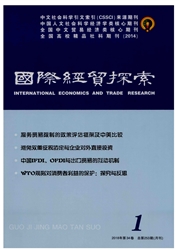

 中文摘要:
中文摘要:
通过两个国家、N种中间投入品以及两个企业的简单模型分析,发现相对于通过吸引外资以及通过国际贸易获取的中间产品,通过本国企业开展对外直接投资在国外生产中间产品比本国的生产更加具有针对性.提高了中间产品的效率,从而对本国最终产品技术的提升比其他渠道的国际技术外溢更加有效。同时.均衡分析的结果发现.对外直接投资反向技术外溢的效应受到母国人力资本、研发投入的交互影响。在本国对外直接投资规模不变的情况下,母国更多的人力资本投资和研发投入可以强化这种反向技术外溢效应:而这种反向技术外溢又受到母国与东道国技术差距的交互作用。在本国对外直接投资规模不变的情况下,更大的技术差距有助于更强的反向技术外溢;最后,母国与东道国的技术差距与母国吸收能力之间具有交互作用。
 英文摘要:
英文摘要:
Through a simple expansion of an endogenous technological progress model, the paper tentatively reveals the mechanism of reverse technology spillover by FDI. By making an analysis of the model of two countries, N kinds of intermediate inputs and two enterprises, it finds out that the intermediate products produced by the home country's enterprises in the foreign country through OFDI are more targeted and producitive than those produced by the enterprises through FDI and international trade. Because the efficiency of intermediate products is improved, OFDI is more effective in improving the technology of final products than other channels of international technology spillovers. At the same time, the equilibrium analysis shows that reverse spillover effects of OFDI are affected by the interaction of human capital and home R&D investment. In the condition of FDI scale unchanged, more human capital and R&D investment will strengthen the reverse technology spillover effect. Finally, the technology gap between the home country and the host country has an interactive effect. When the other conditions remain unchanged, a bigger technology gap brings more reverse technology spillovers, but it also makes a higher requirement for the home country' s absorptive capacity.
 同期刊论文项目
同期刊论文项目
 同项目期刊论文
同项目期刊论文
 期刊信息
期刊信息
